JAIST Gallery
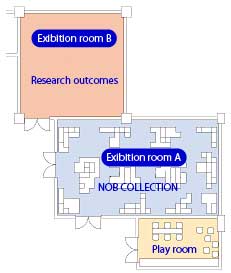
JAIST Gallery opened in September 2012 for the purpose of exemplifying the results of pursuing one’s curiosity through research, education and social contribution. The exhibition showcases an intriguing collection of donated articles.
The gallery replaces some research exhibits periodically. It houses approximately 10,000 donations of the “NOB puzzle collection,” – one of the largest and best puzzle collections in the world assembled by the late YOSHIGAHARA Nobuyuki, a world-famous puzzle inventor and collector. Some 200 pieces selected from the collection are displayed in the gallery. The Gallery itself is designed featuring an assembly puzzle. It has a playroom where children can touch and play with actual puzzles.
⇒ For the gallery leaflet, please click here.
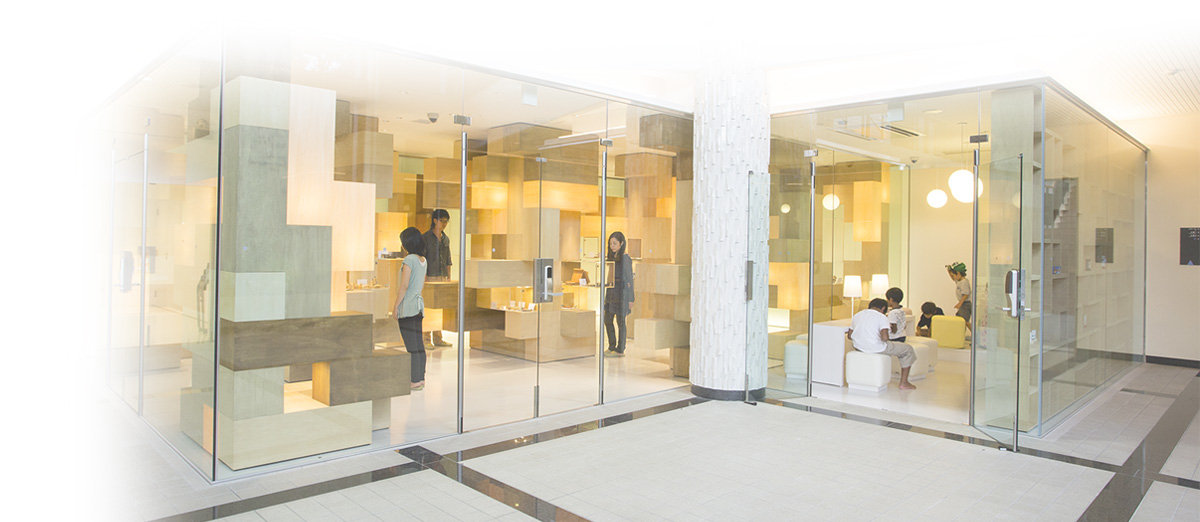
Design:MATSUDA Tatsu / Tatsu Matsuda Architects
RINNO Noriko / Rinno Architectural office
- Reservation
- Admission to JAIST Gallery requires a reservation in advance.
- Please make a reservation via phone or e-mail.
Opening.
- Hours : 9:30-16:30 (Weekdays only)
- We accept groups of up to 20 visitors at onetime.
- No admission fee is required.
Japan Advanced Institute of Science and Technology
Public Relations Section, Office of Public Relations
Adress: 1-1 Asahidai, Nomi, Ishikawa. 923-1292 Japan
Phone: +81-(0)761-51-1031 E-mail: kouhou@ml.jaist.ac.jp
- “NOB COLLECTION” – one of the greatest puzzle collections in the world –
-
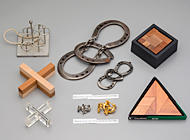 NOB’S PUZZLES
NOB’S PUZZLES
For Yoshigahara's collection of works was not an end in itself but a way to accumulate reference materials for his creative activities. In addition to his works, the collection includes many reference materials to show his creation processes. The miniature playground equipment in Nob’s puzzle collection is one example of his wide range of puzzle creation activities.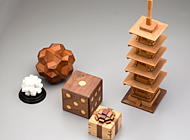 PUZZLES PRODUCED BY SUPURB PUZZLISTS
PUZZLES PRODUCED BY SUPURB PUZZLISTS
The Nob Yoshigahara Award has been presented to excellent puzzlists for “Lifetime Achievements in Design, Craftsmanship, and Popularizing Mechanical Puzzles.” So far, it has been awarded to two puzzlists: Stewart Coffin, an American designer of wooden puzzles, and KAMEI Akio, a creator of “Karakuri box” (trick opening box), who is active in the Hakone area in Japan. Also in Hakone is NINOMIYA Yoshiyuki, a master craftsman of traditional woodwork and a creator of superlative interlocking wooden blocks, secret boxes, and beautiful yosegi trick woodworks. The five-storied pagoda in the picture is considered one of his masterpieces.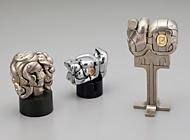 BERROCAL’S PUZZLES
BERROCAL’S PUZZLES
There is a collection of works by Miguel Berrocal, a Spanish puzzle artist. Berrocal learned mathematics and architecture at the University of Madrid, Spain, and learned art in Paris and Rome. Although most of his pieces are hard-to-solve 3D jigsaw puzzles, they are regarded as “puzzle sculptures,” not just toys for children. Mr. Berrocal incorporated a finger ring in some of his works, and he made a number of copies of the originals in his workshop.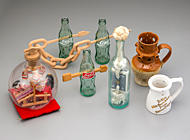 MYSTERIOUS OBJECTS
MYSTERIOUS OBJECTS
‘Puzzle vessels’ including a jug without any apparent drinking orifice, a teapot which confounds the pourer, and ‘mysterious impossible objects’ that seem to be impossible to exist, are parts of this category. They are created to make people think hard to find the answer to those mysteries. The Japanese bottle objects are also a family of this type of puzzles.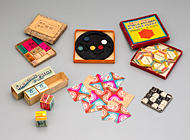 SLIDING PIECE PUZZLES & MATCHING PUZZLES
SLIDING PIECE PUZZLES & MATCHING PUZZLES
From olden times, various puzzles have been used. Sliding piece puzzles slide pieces around a board to achieve a determined shape or position and matching puzzles arrange the matching pieces, edge colors, or patterns. The black circular article in the picture is the oldest resin-made puzzle (patented in 1895). The VESS puzzle is an historic 3 by 3 matching puzzle of earlier origin.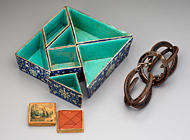 WIRE PUZZLE & DISSECTION PUZZLES
WIRE PUZZLE & DISSECTION PUZZLES
Both the wire puzzles (to remove one of multiple pieces tangled up with one another, then return the puzzle to its original position) and the dissection puzzles (to form a given shape by assembling a set of pieces) have been made in various types and materials from ancient times. The horseshoe puzzles is made of used horseshoes. The tangram is a dissection puzzle, which was invented in China and then brought to Europe.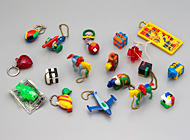 KEY CHAIN PUZZLES
KEY CHAIN PUZZLES
A key chain puzzle denotes a small puzzle with a key ring, or one made attachable to a key ring. There are many sub-types of key chain puzzles made of different shapes and materials. The plastic assembly type of the key chain puzzle was created in the United States in the late 1930’s. Then it was introduced to Japan, and some Japanese variations were developed.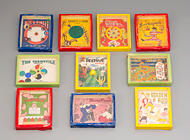 DEXTERITY PUZZLES
DEXTERITY PUZZLES
Dexterity puzzles require the use of manual dexterity. The most typical is the Cup & Ball. Some other types of dexterity puzzles are brainteasers. There are a huge number of puzzles to play with moving a ball on a board. Some puzzles hold historic significance with important historical events like wars incorporated into them.
